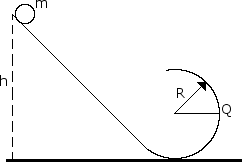Rotational Kinetic Energy Physics Problem
A light string that is attached to a large block of mass 4m passes over a pulley with negligible rotational inertia and is wrapped around a vertical pole of radius r, as shown below. The system is released from rest, and as the block descends the string unwinds and the vertical pole with its attached apparatus rotates. The apparatus consists of a horizontal rod of length 2L, with a small block of mass m attached at each end. The rotational inertia of the pole and the rod are negligible.

D. When the large block has descended a distance D, how does the instantaneous total kinetic energy of the three blocks compare to that in part (C), Greater, Equal, or Less?
SOLUTION MISSING: Unfortunately the author of this youtube video removed their content. You may be able to find a similar problem by checking the other problems in this subject. If you want to contribute, leave a comment with the link to your solution.
Related Problems
A massless string is wrapped around a disk of rotational inertia I = . The disk falls and spins as it falls, unraveling the rope. Determine the tension in the string and the acceleration of the disk.

A solid brass sphere of mass m and radius r << R rolls along a track when released from rest along the straight section. The circular loop has a radius R.

B. Assume the sphere is released at height h = 6.0 R, what are the magnitude and direction of the horizontal force competent acting on the sphere at point Q?
A uniform disk is mounted to an axle and is free to rotate without friction. A thin uniform rod is rigidly attached to the disk so that it will rotate with the disk. A block is attached to the end of the rod. Properties of the disk, rod, and block are as follows.

C. Determine the linear speed of the mass at the end of the rod for the instant the rod is in the horizontal position.
A solid disk of unknown mass and known radius R is used as a pulley in a lab experiment as shown below. A small block of mass m is attached to a string, the other end of which is attached to the pulley and wrapped around it several times. The block of mass m is released from rest and takes a time t to fall the distance D to the floor.

D. The value of acceleration found in (B)iii, along with numerical values for the given quantities and your answer to (C), can be used to determine the rotational inertia of the pulley. The pulley is removed from its support and its rotational inertia is found to be greater than this value. Give one explanation for this discrepancy.